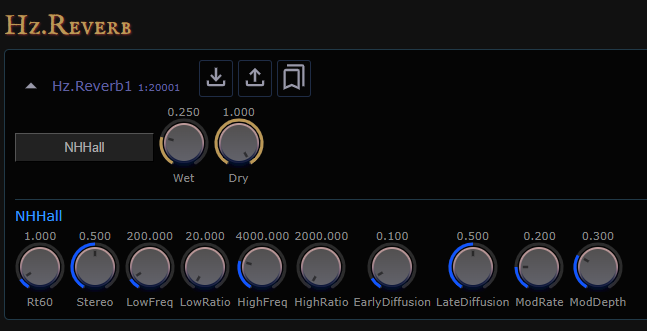REF / Hz.Plugins / Hz.Reverb
Hz.Filt, Hz.Echo, Hz.Delay, Hz.Reverb
Hz.Mix, Hz.LFO, Hz.ADSR
see also Hz.Builtins, Plugin Explorer, Hz.Plugins Examples
Wherein we ruminate on the finer points of Hz.Reverb.Sound designers often have strong opinions about reverb. If you are one of those and have a favorite reverb plugin, then by all means stick with it. We provide
Hz.Reverbto ensure that a reasonable reverb option is available out-of-box. Most synths include one or more reverb options in their effect pipeline as well.
Hz.Reverb
Hz.Reverb is a standalone CLAP plugin that is also a component of
other Hz plugins like Hz.Syntho and Hz.Samplo.
Its job is to simulate the reverberating effects of an enclosed space.
Hz.Reverb supports one input and output port. These can be
configured mono or stereo.
Hz.Reverb supports two distinct reverberation algorithms,
SignalSmith and
NHHall. SSReverb44 and its
slightly more expensive sibling SSReverb88 produce excellent results
with only 4 parameters making it the preferred/default reverb.
Webview GUI
SignalSmith

NHHall

Parameter Synchronization
Each Hz.LFO panel includes the parameter synchronization controls at top.
download syncs the GUI with the current state of the associated instance.
upload pushes the GUI parameter settings to the associated instance.
bookmark selects from a list of named parameter settings.
Parameters
| General Parameter | Id | Description | Range |
|---|---|---|---|
Dry |
1 | The amount of the dry signal | 0-1 (1) |
Wet |
2 | The amount of the reverb signal | 0-1 (.25) |
Model |
3 | Selects the Reverb Model | 0:Passthrough, 1:SSReverb44, 2:SSReverb88, 3:NHHall |
On Rt60
Both algorithms include an Rt60 parameter that represents the reverb time
in seconds before the signal reaches 60dB attenuation. Here are some
general guidelines from Larson Davis.
RT60 < 1s: Good for classrooms.
RT60 = 1s: Good for speaking: articulation of speech is clear.
Music doesn’t sound full, rich, or warm at this level.
RT60 = 1.5s to 2.5 s: A good compromise if the room is to be
used for both speaking and music.
RT60 = 3.5s: Better for music, but some loss of articulation.
Would likely be difficult to understand speech.
RT60 = 8s to 11s: Large medieval cathedrals will have a very
long RT60! This is by design as the long reverberation time
is well suited to organ music or the unaccompanied voice
(for example, Gregorian chants).
SignalSmith Parameters
| Parameter | Id | Description | Range |
|---|---|---|---|
SSRt60 |
30 | 60db Attenuation Time (seconds) | 0-10 (1.5) |
SSRoomSize |
31 | Room Size (m) | 3-200 (10) |
SSHighShelfFreq |
32 | Frequency to apply high shelf frequency attenuation | 3000-12000 (8000Hz) |
SSHighShelfGain |
33 | Amount of High-Shelf Attenuation | -6-0 (0 dB) |
SignalSmith Notes
The difference between SS44 and SS88 is relates to the number of independent mixing channels, where more channels means more expensive. For more details, see this great blog post.
NHHall Parameters
| Parameter | Id | Description | Range |
|---|---|---|---|
NHRt60 |
10 | 60db Attenuation Time (seconds) | 0-10 (1) |
NHStereo |
11 | Rate at which audio spreads between the left and right channels. | 0-1 (.5) |
NHLowFreq |
12 | Low Frequency Cutoff | 20-2000 (200) |
NHLowRatio |
13 | The decay rate multiplier for low frequencies. Set this to 1 to use the same decay time as the mid frequencies. | 0-1 (.5) |
NHHighFreq |
14 | High Frequency Cutoff | 2000-10000 (4000) |
NHHighRatio |
15 | The decay rate multiplier for high frequencies. Set this to 1 to use the same decay time as the mid frequencies. | 0-1 (.5) |
NHEarlyDiffusion |
16 | The coefficient for the early reflection Schroeder allpass filters. Ranges from 0 to 1, but most normal reverbs will use 0.5 to 0.9. Higher values have a sharper attack and add metallic coloration to the signal. | 0-1 (.1) |
NHLateDiffusion |
17 | The coefficient for the late reflection Schroeder allpass filters. Ranges from 0 to 1, but most normal reverbs will use 0.5 to 0.9. Higher values have a sharper attack and add metallic coloration to the signal. | 0-1 (.5) |
NHModRate |
18 | Modulation rate for late reflections. | 0-1 (.2) |
NHModDepth |
19 | Modulation depth for late reflections. | 0-1 (.3) |
NHHall SuperCollider Notes
NHHall as more parameters offering you both more control and more
opportunities to end up in a bad place.
NHHall is a general-purpose stereo-to-stereo reverb. Both the early and late
reflections are "true stereo," designed so that the reflections bloom outward
from the panned positions of the input signal. Random modulation adds lush
chorus effects to the sound.
A practical reverb should generally have a predelay, and post-EQ (or pre-EQ). Since these are elementary to write in SuperCollider, they are not built in.
For a mono-to-stereo reverb, turn the input signal into a stereo signal with Pan2. For a mono-to-mono reverb, turn the stereo spread up to 1 and use only the left or right output channel. It is not advisable to sum the two channels together due to the use of the Haas effect in the output taps.
The reverb can be frozen by setting the reverberation time to infinity. Empirical tests have shown that this remains stable for at least a few minutes.
This reverb was written by Nathan Ho specifically for SuperCollider, ChucK, and Auraglyph (an open source modular synth for iPad).